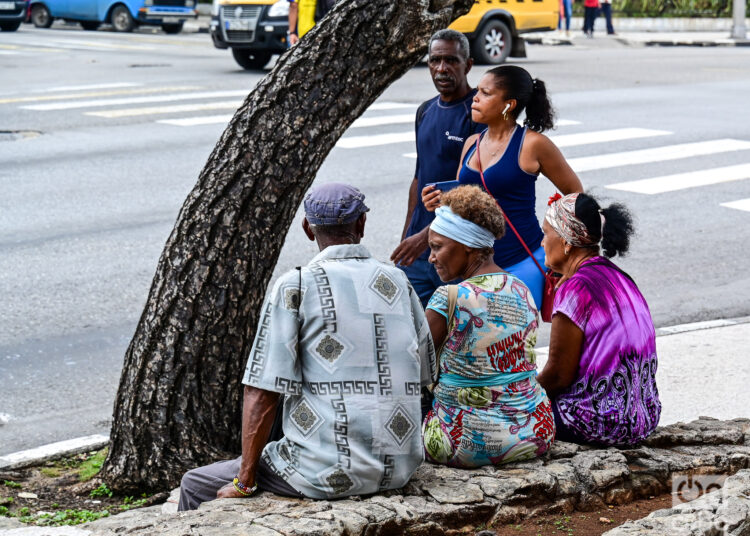Re-watching Miracle in Milan (Vittorio de Sica, 1951), one of those film gems they call “old movies,” I recovered an almost forgotten scene. Among the crazy troop of poor people who make wishes for their most secret desires to a patron saint, some lovers who never speak to each other, she white and he black, cross their desires, so that both change color at the same time. The parable of the transracial couple seems to tell us that love does not require becoming the same as the other because both will continue to be different; it lies rather in the union of different beings.
In addition to its feverish imagination, this classic neorealist comedy impresses as a great mural caricature of Italian society. Landowners, police, bureaucrats, and a large contingent of poor people; from rogues and innocent girls to ruined bourgeois who continue to believe themselves superior, to union leaders and neighborhood tough men. Each one with their own way of thinking and speaking.
That way of speaking, its various discourses, are the mirror of representations and self-perceptions, and also of alienations.
A mirror-like that between us is the lexicon that collects the differences in skin color, shape and color of hair, eyes, and other physiognomic features associated with the so-called “racial differences.” Taking into account the combination of these traits, the National Prize for Social Sciences and prominent anthropologist Jesús Guanche, brought together almost three decades ago a repertoire of 20 Cuban phenotypes extracted from popular speech, showing that racism is manifested most crudely in everyday expressions:
Black-blue (very dark and matt skin; very curly and black hair; black eyes); telephone color (very dark and shiny skin; very curly hair; black eyes); coco timba (very dark skin; very curly hair, like peppercorns and separated from each other; black eyes); pointy head (very dark skin, very curly black hair; black eyes; prominent dolichocephaly); black (tan skin of varying intensity; curly black hair; dark brown or black eyes); Moor (brown skin, slightly curly hair and black eyes); mulatto (tan skin of varying intensity; curly black hair; dark brown or black eyes); Indian (cinnamon or tanned skin; very black and shiny straight hair; black eyes slanted by epicanthic fold); Chinese mulatto (cinnamon or light tan skin; somewhat curly hair; black eyes slanted by epicanthic fold); paper cone-colored mulatto (light tan skin; slightly curly black hair; dark brown or black eyes); white mulatto (very light cinnamon skin; slightly curly brown or black hair; brown or black eyes); dark-skinned (tanned skin; slightly curly black hair; black eyes); jabao (cinnamon or ocher skin; curly and blond hair; brown or light green eyes); red (reddish and freckled skin; curly or wavy and reddish hair; brown eyes); Chinese (yellowish skin; very straight and black hair; black eyes slanted by epicanthic fold); white (light skin; straight or wavy hair, and brown or black eyes); blonde (light skin; straight or wavy blonde hair; green, blue, or light brown eyes); shore white (connotation of “marginal” or “mestizo”: light skin resistant to the sun; wavy or curly black hair; dark brown or black eyes); milky white (very light, freckled skin; straight or wavy, light brown hair; brown or black eyes); albino (depigmented skin; curly or very curly and light blonde hair; light eyes).
“All these names can have, depending on the context, an affective or derogatory connotation” [Jesús Guanche, “Etnicidad y racialidad en la Cuba actual,” Temas, # 7, July-September, 1996].
Prohibiting those so-called racial phenotypes that “everyone uses” among us could be sterile and even counterproductive. As often happens many things are ordered to be removed with the best of intentions. Let’s say, the question about race or skin color in the 1970 census, supposedly to prevent these differences from being perpetuated in prejudices and racist stereotypes.
What I want to say is that outlawing discourses with a racist, sexist, or homophobic bias that devalue farmers or poor people in public spaces is not enough for them to tend to disappear due to disuse. The accumulated experience rather demonstrates that these discourses survive in good health in communities of all types, groups and real social media (less visible than digital ones), informal spaces such as the majority of private, generational and family spaces, in which the correct-incorrect is redefined according to assumed codes. In these interstices, which encompass the whole of real society, social virtues and alienations cohabit.
If that were not enough, the norm itself accepted or considered correct can be problematic. For example, when it promotes practices such as the poor and their culture being called “marginal,” colloquialisms of African origin being classified as “slang” and “misuse of language,” people with certain characteristics being classified as “handicapped.”
What to do with the discourse where those twenty phrases of popular speech are replicated? Is it possible to exorcise them of their alienating, negative charge? Is there a way to deal with them without trying to ignore them or directly outlaw them, without reinforcing their roots and proliferation? For what interests us here and now: can art contribute to intelligently managing them and turning them into doors that facilitate access to critical social awareness, generated from below, not from above?
Based on all of the above, I just want to outline three problems.
First: can we encourage and produce anti-racist humor without having understood the causes that reproduce racism here and now?
I once made a series of videos about racism, interviewing a group of anthropologists and activists from Brazil, the United States, and Cuba. Their analysis elaborated a group of problems about the complexity of racism, its intersection with other inequalities (class, gender), its instillation in family and community culture, its not always visible transfer to other forms of civic or political exclusion.
When I showed it to a leader friend, he reacted by saying that these approaches were superficial because they ignored the most important thing: that racial discrimination comes from slavery.
Naturally, I told him. But that is also a simple way to ignore the problem. If we reduce it to a remnant of the past, a kind of hereditary disease, that comes from the barbarism of some Spaniards foreign to us, are we understanding it to change it? Can that explain why it is still there 140 years after abolition, after three revolutions that shook social relations and politics, after nine generations of Cubans, and after 65 years of socialist education?
To be effective, anti-racist or anti-colonial humor cannot be based on a 19th-century evil, nor on replicating the countercultures of the 1960s, or on affirmative action (quota policy). But, rather, to be exerted on that racist and that fan of what is American that we have in our guts. Extirpating it, in the name of nativism typical of indigenous cultures, instead of transforming it with the resources available today, is like trying to get rid of an intestinal infection with purgatives that destroy the microbiome, those little bugs that defend us from almost all diseases.
The experience with other childhood infections in our political and ideological culture shows us that an effective paradigm to treat them is not surgery, antibiotics, or condoms, but rather the vaccine. An anti-racist and anti-colonial vaccine — for the entire population, not just for the part with symptoms — for which humor and other arts can help to apply, perhaps more flexibly and immediately than the educational system itself, with more effective and attractive resources than the academic commissions and conferences, than campaigns and slogans promoted again and again from above or below.
Second: to what extent can humor that addresses the racial topic contribute to raising awareness of racism?
As with so many other problems in our society, economy, culture, policies, the stereotype of seeing ourselves as “the weird ones” does not help us think about and imagine alternatives.
If you search for “racism in jokes” on Bing or Google, you will see that it is a topic debated in Peru, Mexico, Spain, the United Kingdom, Colombia, right now. If we differ in anything in Cuba, it is that there are no equivalent debates in our media.
As a Mexican comedian, Mónica Escobedo, recently pointed out:
Nobody has done a routine that makes us think, that makes us see how ridiculous it is to discriminate against anything…. Corrosive humor makes me look at the racism of which I am the object; also the one that I exercise without realizing it and the hidden racism in the humor that I had not seen.
Considering the experience of these Mexican comedians and others from the United States, the use of humor can begin precisely by exploding stereotypes about blacks and Indigenous people. Precisely because they are put to the test, in contrast to real society, as, say, Richard Pryor or Chris Rock.
There is a legion of topics for that humor among us. The stereotypes and prejudices that permeate our daily lives, and that make us behave in contradictory ways, saying one thing and doing another; the mental habits and prefabricated responses of those who dialogue without much desire, and attribute the racial lines of poverty to the economic crisis; stereotypes about poor neighborhoods and the idealization of social programs as a panacea; the manipulation of the racial topic by those who fuel it with their anti-government political agendas. Etc.
Third: What and how to learn from our cultural legacy?
Pototo y Filomeno, Chicharito y Sopeira, La tremenda corte [Cuban radio TV programs], are part of that legacy, just like the comic theater, the Ramón Peón films, the Ñico Saquito guarachas. But it is one thing to recover them and another to restore aesthetic patterns and sensibilities to make art here and now. Especially humor that exorcises stereotypical representations.
This legacy of Cuban humor contains, however, some useful lessons. When we hear Bola de Nieve sing “Mesié Julián” or “Mamá Perfecta,” Luis Carbonell recites “Negra Fuló,” “Y tu abuela dónde está,” “Los quince de Florita,” and Nicolás Guillén himself in “Negro bembón” and “Victor Manue tú no sabe inglé,” the fine line between dealienating humor and stereotype becomes very clear.
These same examples seem to reveal that it is not about the humorous tone or the negative charge of themes and characters but about the dealienating function of art. We return to the central problem between Alfredo Guevara and Blas Roca in 1963, about the sense of showing films like Accatone and Alias Gardelito, whose protagonists are criminals, instead of positive heroes. If we talk about a cinema that does not idealize its characters, but rather reveals their alienations, why assume that viewers are passive consumers, inept at coming to their own conclusions?
This dealienating function does not consist of portraying a world as it should be, but rather of enabling viewers to judge for themselves the defects of a society that has not freed itself from inequality and injustice, nor from alienated behavior. De cierta manera (1974) and Techo de vidrio (1981), works by two black filmmakers focused on these disadvantages, could serve as an example of how to dare to do it well, even when facing censorship.
In a recent debate dedicated to what is right and wrong in humor, I mentioned that comedies such as La muerte de un burócrata (1966) and Aventuras de Juan Quin Quin (1967), screened with great public and critical success, used, in those such difficult and polarized years, a corrosive humor with the defects of the socialist State apparatus and with the doctrine of the guerrilla focus. A veteran comedian told me, not without a hint of nostalgia, that those were glorious years for humor in cinema, like never before.
It would be worth commemorating it, I would say, with works that fully embrace that legacy.










